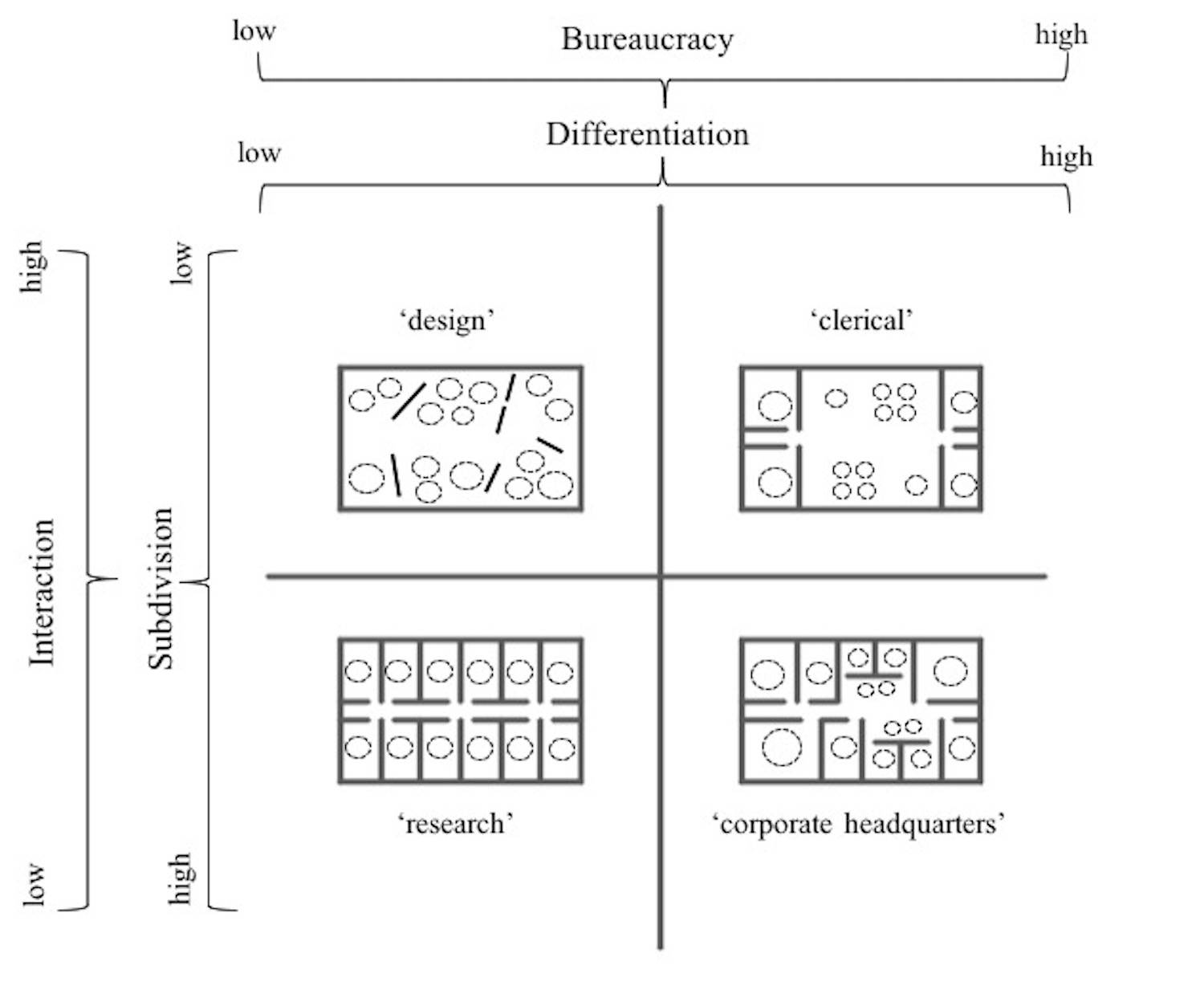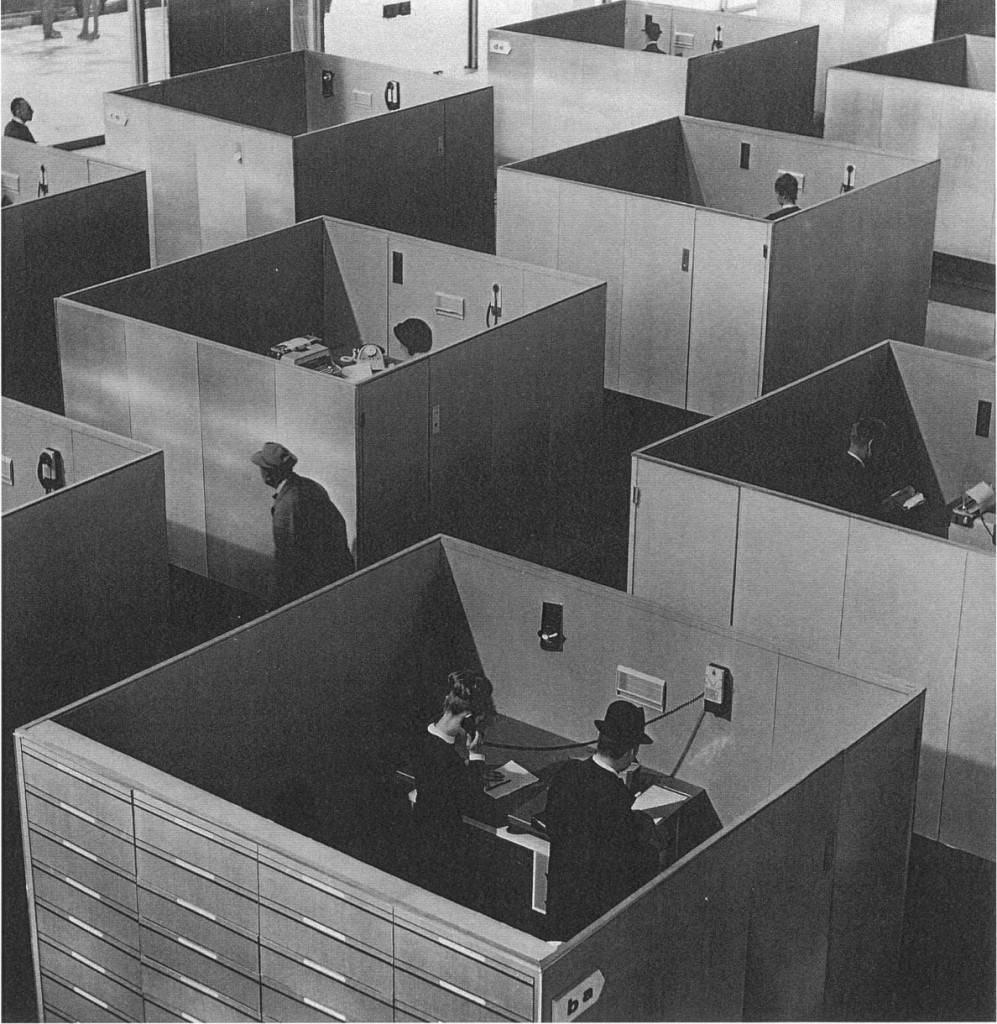 I spent some time with Frank Duffy recently, releasing a stream of memories of working with him, first as an employee at DEGW during the 1980s, and then as a client while directing developer Stanhope’s research programme during the 1990s. Along with his long-term business partner, John Worthington, and thinkers including Franklin Becker, Gerald Davis, Michael Joroff and Jack Tanis, to name a few, Frank helped sketch out the grand scheme of what we now call ‘workplace’. Much of the work of their successors has involved filling in the matrix of detail within the grand scheme. But further reflection has caused me to ask whether, in filling in the finer details, we have recently somehow lost our way. Are we, the ‘workplace profession’, instead of standing on giants’ shoulders, now just pandering to fads and fancies? Or, even more radical, might it be that ‘workplace’ is now done, and that we’ve run out of meaningful things to say?
I spent some time with Frank Duffy recently, releasing a stream of memories of working with him, first as an employee at DEGW during the 1980s, and then as a client while directing developer Stanhope’s research programme during the 1990s. Along with his long-term business partner, John Worthington, and thinkers including Franklin Becker, Gerald Davis, Michael Joroff and Jack Tanis, to name a few, Frank helped sketch out the grand scheme of what we now call ‘workplace’. Much of the work of their successors has involved filling in the matrix of detail within the grand scheme. But further reflection has caused me to ask whether, in filling in the finer details, we have recently somehow lost our way. Are we, the ‘workplace profession’, instead of standing on giants’ shoulders, now just pandering to fads and fancies? Or, even more radical, might it be that ‘workplace’ is now done, and that we’ve run out of meaningful things to say?
Back to the beginning …
I ask these questions because much workplace ‘research’ that I have read in recent years (say, the past five) is not research in the commonly-accepted sense of the term. Rather, much of it is agenda-driven, serving the purposes of narrowly-defined interest groups. Some of it is simply opinion gathering, in the tradition of “eight out of ten cat owners said ….”, with little attention given to social science rigour. Some of it is so devoid of context that it simply crumbles to dust when methodologies are exposed to scrutiny.
Duffy began to publish back in the 1970s and, for my money, one of his earliest articles counts among his most incisive and instructive. The figure represented here (by today’s MS Office standards, a somewhat primitive diagram) appeared in a 1974 article, arguing that different organisational characteristics demand various kinds of office layouts.

The fact is that an organisation and an individual will have different perspectives on what is a ‘good’ workplace. The design imperative is to provide settings which accommodate a balance between the corporate and individual perspectives. Duffy was one of the earliest to link organisational ecology with physical form.
A decade after Duffy’s article two Harvard academics, Philip Stone and Robert Luchetti, released a landmark article in which they sought to … challenge the customary ways of thinking about offices and show how managers can gain the advantages and avoid the disadvantages of the new technologies. Managers can integrate physical layout, design, and communications to support organizational objectives that:
• Emphasize informal exchange.
• Reassign people to different work teams and study groups.
• Provide many employees access to specialized equipment.
• Value individual initiative and mobility.
• Derive payoffs from serendipity.
• Attract talent employees. Increase productivity while reducing office costs.
The authors went on to suggest that: Any coherent rethinking of an office plan requires that management integrate facilities, communications, and computers in accord with company objectives. The article was, possibly, the first formulation of what we now call activity-based workstyles. (For an extended discussion of the benefits and risks surrounding open plan offices, see also “Keeping an open mind about the open plan office” by Maciej Markowski in Work&Place #5 from May 2015)
These two articles illustrate the role of research in helping us understand the relationship between organisation and worker. And, of course, there have been many enlightening pieces of research since these early examples: it would be quite wrong to suggest otherwise.However, over the past few years there seems to have been a step-change in the quantity of material vying for attention and, yes, a consequent dilution in the overall quality of the work.
Barely a week passes without some new research purporting to offer fresh insight into how today’s workplace can be nudged in the direction of a more perfect future. Three thematic examples will suffice to illustrate the nature of the problem: open and enclosed space planning; wellbeing in the workplace; and the march of the millennials.
Open and enclosed space planning
As long ago as 1994, in his much-underrated book How Buildings Learn, Stuart Brand discussed an American model, referred to as ‘caves and commons’, whereby office workers had private offices, often quite small, opening onto generously-planned open areas surrounded by other private offices.
The open area contained vending, couches and informal meeting tables, possibly even a library. Such an arrangement meant that a worker “could shut the door of your cave and concentrate, or you can leave your door open and keep an eye on who’s coming and going in the commons”. The ambience is “congenial and homey” encouraging “casual encounters which … are at the heart of creativity in offices”.
Such a model was given further expression a few years later in New Environments for Working, which introduced the idea of cells, clubs, dens, and hives as alternative work settings. Such work oozed common sense rather than design sense.
 And yet, two decades on, every once in a while, the mainstream press picks up on a piece of research that hints at the failings of open plan offices. And every time there is a misrepresentation of the issue: open versus enclosed, rather than which blend of settings is most appropriate for the circumstances in question? Open and enclosed is not a binary choice; those designs are opposite poles with a spectrum of blends between .
And yet, two decades on, every once in a while, the mainstream press picks up on a piece of research that hints at the failings of open plan offices. And every time there is a misrepresentation of the issue: open versus enclosed, rather than which blend of settings is most appropriate for the circumstances in question? Open and enclosed is not a binary choice; those designs are opposite poles with a spectrum of blends between .
Why is it so difficult to move on? Why do we have to repeatedly return to the ‘open plan is bad for you’ discussion? The most recent example is a Harvard Business Review article by Ethan Bernstein and Stephen Turban. The five-and-a-half-page article, supported with eighty-five references (perhaps the largest citation-to-page-count ratio I’ve ever seen) is based on two field studies of corporate HQs undergoing transformation to an open plan format. The study examined the effect of open office design on face-to-face, email, and instant messaging interaction patterns, with workers using wearable devices to monitor activity.
The main counter-intuitive finding was that the volume of face-to-face interaction decreased significantly, with a concomitant increase in electronic interaction. The authors suggest that, rather than increasing collaboration, open plan design “appeared to trigger a natural human response to socially withdraw from officemates and interact instead over email and IM”.
My colleague Nigel Oseland has recently pointed to the methodological problems with this piece. He hinted at the problem of subjects’ behaviour being influenced by the act of monitoring and pointed out that the quality of the open plan design was unknown.
The point is, we have yet another piece of research that perpetuates the binary discussion of open versus enclosed. It does not take the subject further forward but re-treads old arguments in an academic cul-de-sac. Moreover, it sends a confusing message to clients and office workers, by reinforcing the conception that ‘workplace’ is about space efficiency rather than something that negotiates the three-dimensional world of people, place, and process.
Wellbeing in the workplace
The second theme here is the apparently parlous state of the UK office workforce. This is not a small constituency: office workers comprise around ten million people, or one-third of the entire workforce. So its overall welfare is an important issue.
I have become inured to the Government’s constant wail that the UK’s productivity is lagging our competitors, but I am also struck by the burgeoning volume of research pointing to workplace factors affecting productivity. A cursory scan through my workplace cuttings file, just for the past twelve months, yields a crop of misleading research headlines.
Can it really be that ten million workers, in a modern economy, can be so ailed? Three million of them too stressed to book a holiday? Even allowing for some crude double-counting, it seems that most of our office workers suffer in some way from the physical and managed workplace. This catalogue of ills suggests not so much an economic enigma as a national crisis.
What does all this research tell us? More to the point, what does it tell us about the state of research itself?
Most work of this kind relies upon self-assessment, whereby individual workers record whether they “feel” or “believe” that their effectiveness is affected by the environment, facilities, furniture, space planning and so on.

The Hunting of the Snark illustration by Henry Holiday
Leaman and Bordass recognised the significant difficulty of defining a productivity measure for office occupiers, suggesting instead self-reporting on workplace factors as an acceptable surrogate. Indeed, most practitioners and academics seem to take the view that in the absence of anything else, this approach will suffice. Again, while this is not wrong, such data cannot possibly contextualise the motivations of the individual: how closely they are aligned with the organisation, their general level of work satisfaction, or their relationships with colleagues and bosses.
One of the key problems with the workplace profession is that there is an underlying sense that a perfect workplace is waiting to be discovered, and that if we can only correct this or that issue, then we will move ‘forward’, make progress.This is, of course, fantastical. A chimera. The crux of Duffy’s approach was that there will always be a trade-off between the organisation and the individual, yet most research addresses only one side of this equation. Moreover, no matter how well-planned and responsive the work environment is, if individuals are not comfortable, or aligned, with the organisation, their effectiveness will suffer.
Conversely, individuals who are highly aligned to an organisation, and deeply motivated by their work, might put up with all manner of workplace discomforts and shortcomings while at the same time being highly productive.
Wellbeing research is suffering from the same reductionist problems as space planning: the focus of interest in each study is now very narrow and yet the results are expected to help ‘explain’ a much broader set of issues. But, in stretching results in this way, the overall credibility of an important avenue of enquiry is fundamentally weakened.
The march of the millennials
Our third example relates to the outpouring of ‘research’ (I resisted the inverted commas in the previous two examples, but simply have to use them for emphasis here), is the tsunami of reports describing the workplace experience of those born since 1980 – the millennials.
Never in the field of workplace thinking has so much hogwash been written by so many about so little.
Despite reading countless articles referring to the matter (and I have an electronic filing cabinet stuffed full of them), I’ve not seen a single shred of credible evidence that millennials form a distinct sub-set of demand. The workplace needs of all age groups have evolved rapidly over the past twenty years, as society, technology, and the economy have evolved.
My workplace needs as a fifty-something are radically different from when I worked with Frank Duffy as a twenty-something. The fact that the ‘tools’ of the office are different, that modes of communication are changing, and that attitudes to social structures and mores are also changing, does not lead to a sub-culture of demand for one cohort of workers.
The most foolish images of the millennial workplace bring bean bags and billiard tables to the fore (forgetting that even half of the millennial demographic are introverts) along with the faintly threatening (or should that be ‘absurd’) notion that you must be happy in the workplace. And ‘research’ has done little to dispel such nonsense.
The crux of the problem
What do these themes (and others) have in common?The relatively recent tendency to see the workplace as a lever of organisational effectiveness has led to an almost frantic search by designers to demonstrate how this or that aspect of the workplace experience can influence productivity, satisfaction, wellbeing, and so on. Environmental quality, facilities services, furniture, heating and lighting, and space planning are all routinely cited and measured. But, in the rush to describe these micro-influences, the context of Duffy’s grand scheme is forgotten.
The real danger of extrapolating the impact of context-free influences is a form of reductionism: the tendency to divide the world into ever-smaller boxes until, finally, we find one that helps to confirm our expectations. This process of description and categorising is comforting because it gives us a level of simplicity that isn’t otherwise there. The danger comes when we use these specific boxes to generate prescriptive models that claim to provide a more general understanding. Such output can be used to help paint a picture that is incomplete and, at worst, possibly hopelessly wrong. Reductio ad absurdum.

Walter Paget’s illustration for Robinson Crusoe
Current approaches to workplace planning are not wrong, per se, but their limitations must be recognised. For example, empirical work usually limits the definition of effectiveness to that of the individual (rather than the organisation), and it tends to limit the definition of the workplace to the physical aspects of the fit-out.
Such approaches define the work environment as a physical entity, largely ignoring the business, social, and systemic influences on performance. In other words, there is a danger that a set of narrowly focused variables is stretched almost to breaking point in an effort to explain issues or solve problems that actually require “cross-cutting” thinking in order to provide workable and sustainable solutions.
And herein lies the crux of (what I see as) the problem. The world of ‘workplace’ today is standing in splendid isolation, adding yet another narrowly defined silo to an already silo-rich supply industry that have worked against the interests of clients (occupiers) for decades. Instead of becoming the integrative force that Duffy and colleagues envisaged back in the 1980s and 1990s, ‘workplace’ is today marooned on an island of increasing irrelevance. It is a little-known fact that Frank Duffy was instrumental in bringing facilities management to the UK, not as a distinct activity, but as an integral part of the grand scheme. How many of today’s ‘workplace’ experts understand that lesson?
So, what to do with the messenger….
The title of this opinion piece asks whether the time has come to shoot the messenger. Perhaps less provocatively, has the time come for some mild push-back against poor research and marketing masquerading as research? The question was posed in the context of a concern that recent trends in research were suggestive that ‘workplace’ is somehow losing its way, or even that we’ve run out of meaningful things to say.
My own sense is that ‘workplace’, certainly as expressed through the research that is used to underpin its approach and methods, is moving backwards. Rather than standing on the shoulders of pioneers who set a path towards integrated thinking about people, technology, and place, it is retreating into a remote technical corner of an already fractured and inefficient supply industry.
Because of its ability to bring together the three most important concerns of modern organisations – people, technology, and place – workplace has the opportunity to become a pivotal activity, not a side show.
So, yes, we need to shoot some messengers, and we need to re-establish a workplace agenda that speaks to its client community rather than its own echo chamber. Workplace can achieve so much more if it seeks to re-establish the barrier-free nature of enquiry it once had and takes a less reductionist and more integrative approach to people, technology, and place.
Now that would be a fitting tribute to Frank Duffy’s legacy of work.
This piece appears in the new issue of Work&Place, the world’s most influential workplace journal. If you don’t already subscribe, you can do so here as well as access the very best workplace thinking in the archive.
The argument put forward by Rob will be the subject of the after lunch debate at the upcoming Workplace Trends Spring Summit: “The workplace profession is now just pandering to fads and fancies, and the ‘workplace’ is now done: we’ve run out of meaningful things to say”. For the motion: Rob Harris, Ramidus Consulting. Against the motion: Katrina Kostic Samen, the Managing Partner of KKS and President of the British Council for Offices.
Illustration: Simon Heath
_____________________________________________
 Rob Harris works with private and public sector occupiers, helping to prepare premises and workplace strategies. He has a wealth of experience – over 30 years – and he offers practical advice, based on practical experience. Specifically, Rob’s skills lie in briefing, business casing, defining needs, option appraisal, and workstyle strategies. Rob works with clients to align their workplace strategies and operational strategies. He helps them achieve improvements in business performance through more efficient (lower cost) and more effective (higher productivity) workplaces. Much of his advisory work involves helping clients identify, develop, and implement opportunities for organisational change through real estate and facilities planning.
Rob Harris works with private and public sector occupiers, helping to prepare premises and workplace strategies. He has a wealth of experience – over 30 years – and he offers practical advice, based on practical experience. Specifically, Rob’s skills lie in briefing, business casing, defining needs, option appraisal, and workstyle strategies. Rob works with clients to align their workplace strategies and operational strategies. He helps them achieve improvements in business performance through more efficient (lower cost) and more effective (higher productivity) workplaces. Much of his advisory work involves helping clients identify, develop, and implement opportunities for organisational change through real estate and facilities planning.
References:
- Duffy F (1974) “Office Design and Organisations: 2: The Testing of a Hypothetical Model,” Environment & Planning B Vol 1 No 2 pp217-235 (reprinted with special permission from John Worthington).
- Stone PJ & Luchetti R (1985) “Your Office is Where You Are” Harvard Business Review, March-April
- Brand S., (1994) How Buildings Learn: What Happens After They’re Built. Viking
- Laing A., Duffy F., Jaunzens D., and Willis S. (1998) New Environments for Working, DEGW/Building Research Establishment
- Bernstein ES Turban S (2018) The Impact of the ‘Open’ Workspace on Human Collaboration, Philosophical Transactions of the Royal Society B, Vol 373 Issue 1753 DOI (https://doi.org/10.1098/rstb.2017.0239)
- Oseland N (2018) Open Plan v Private Offices Déjà Vu
- Leaman A & Bordass W (2000) “Productivity in Buildings: the Killer Variables“. In: Clements-Croome, D. Creating the Productive Workplace E&FN Spon, London














February 7, 2019
Maybe the time has come to shoot the workplace messenger
by Rob Harris • Comment, Flexible working, Wellbeing, Workplace design
Back to the beginning …
I ask these questions because much workplace ‘research’ that I have read in recent years (say, the past five) is not research in the commonly-accepted sense of the term. Rather, much of it is agenda-driven, serving the purposes of narrowly-defined interest groups. Some of it is simply opinion gathering, in the tradition of “eight out of ten cat owners said ….”, with little attention given to social science rigour. Some of it is so devoid of context that it simply crumbles to dust when methodologies are exposed to scrutiny.
Duffy began to publish back in the 1970s and, for my money, one of his earliest articles counts among his most incisive and instructive. The figure represented here (by today’s MS Office standards, a somewhat primitive diagram) appeared in a 1974 article, arguing that different organisational characteristics demand various kinds of office layouts.
The fact is that an organisation and an individual will have different perspectives on what is a ‘good’ workplace. The design imperative is to provide settings which accommodate a balance between the corporate and individual perspectives. Duffy was one of the earliest to link organisational ecology with physical form.
A decade after Duffy’s article two Harvard academics, Philip Stone and Robert Luchetti, released a landmark article in which they sought to … challenge the customary ways of thinking about offices and show how managers can gain the advantages and avoid the disadvantages of the new technologies. Managers can integrate physical layout, design, and communications to support organizational objectives that:
• Emphasize informal exchange.
• Reassign people to different work teams and study groups.
• Provide many employees access to specialized equipment.
• Value individual initiative and mobility.
• Derive payoffs from serendipity.
• Attract talent employees. Increase productivity while reducing office costs.
The authors went on to suggest that: Any coherent rethinking of an office plan requires that management integrate facilities, communications, and computers in accord with company objectives. The article was, possibly, the first formulation of what we now call activity-based workstyles. (For an extended discussion of the benefits and risks surrounding open plan offices, see also “Keeping an open mind about the open plan office” by Maciej Markowski in Work&Place #5 from May 2015)
These two articles illustrate the role of research in helping us understand the relationship between organisation and worker. And, of course, there have been many enlightening pieces of research since these early examples: it would be quite wrong to suggest otherwise.However, over the past few years there seems to have been a step-change in the quantity of material vying for attention and, yes, a consequent dilution in the overall quality of the work.
Barely a week passes without some new research purporting to offer fresh insight into how today’s workplace can be nudged in the direction of a more perfect future. Three thematic examples will suffice to illustrate the nature of the problem: open and enclosed space planning; wellbeing in the workplace; and the march of the millennials.
Open and enclosed space planning
As long ago as 1994, in his much-underrated book How Buildings Learn, Stuart Brand discussed an American model, referred to as ‘caves and commons’, whereby office workers had private offices, often quite small, opening onto generously-planned open areas surrounded by other private offices.
The open area contained vending, couches and informal meeting tables, possibly even a library. Such an arrangement meant that a worker “could shut the door of your cave and concentrate, or you can leave your door open and keep an eye on who’s coming and going in the commons”. The ambience is “congenial and homey” encouraging “casual encounters which … are at the heart of creativity in offices”.
Such a model was given further expression a few years later in New Environments for Working, which introduced the idea of cells, clubs, dens, and hives as alternative work settings. Such work oozed common sense rather than design sense.
Why is it so difficult to move on? Why do we have to repeatedly return to the ‘open plan is bad for you’ discussion? The most recent example is a Harvard Business Review article by Ethan Bernstein and Stephen Turban. The five-and-a-half-page article, supported with eighty-five references (perhaps the largest citation-to-page-count ratio I’ve ever seen) is based on two field studies of corporate HQs undergoing transformation to an open plan format. The study examined the effect of open office design on face-to-face, email, and instant messaging interaction patterns, with workers using wearable devices to monitor activity.
The main counter-intuitive finding was that the volume of face-to-face interaction decreased significantly, with a concomitant increase in electronic interaction. The authors suggest that, rather than increasing collaboration, open plan design “appeared to trigger a natural human response to socially withdraw from officemates and interact instead over email and IM”.
My colleague Nigel Oseland has recently pointed to the methodological problems with this piece. He hinted at the problem of subjects’ behaviour being influenced by the act of monitoring and pointed out that the quality of the open plan design was unknown.
The point is, we have yet another piece of research that perpetuates the binary discussion of open versus enclosed. It does not take the subject further forward but re-treads old arguments in an academic cul-de-sac. Moreover, it sends a confusing message to clients and office workers, by reinforcing the conception that ‘workplace’ is about space efficiency rather than something that negotiates the three-dimensional world of people, place, and process.
Wellbeing in the workplace
The second theme here is the apparently parlous state of the UK office workforce. This is not a small constituency: office workers comprise around ten million people, or one-third of the entire workforce. So its overall welfare is an important issue.
I have become inured to the Government’s constant wail that the UK’s productivity is lagging our competitors, but I am also struck by the burgeoning volume of research pointing to workplace factors affecting productivity. A cursory scan through my workplace cuttings file, just for the past twelve months, yields a crop of misleading research headlines.
Can it really be that ten million workers, in a modern economy, can be so ailed? Three million of them too stressed to book a holiday? Even allowing for some crude double-counting, it seems that most of our office workers suffer in some way from the physical and managed workplace. This catalogue of ills suggests not so much an economic enigma as a national crisis.
What does all this research tell us? More to the point, what does it tell us about the state of research itself?
Most work of this kind relies upon self-assessment, whereby individual workers record whether they “feel” or “believe” that their effectiveness is affected by the environment, facilities, furniture, space planning and so on.
The Hunting of the Snark illustration by Henry Holiday
Leaman and Bordass recognised the significant difficulty of defining a productivity measure for office occupiers, suggesting instead self-reporting on workplace factors as an acceptable surrogate. Indeed, most practitioners and academics seem to take the view that in the absence of anything else, this approach will suffice. Again, while this is not wrong, such data cannot possibly contextualise the motivations of the individual: how closely they are aligned with the organisation, their general level of work satisfaction, or their relationships with colleagues and bosses.
One of the key problems with the workplace profession is that there is an underlying sense that a perfect workplace is waiting to be discovered, and that if we can only correct this or that issue, then we will move ‘forward’, make progress.This is, of course, fantastical. A chimera. The crux of Duffy’s approach was that there will always be a trade-off between the organisation and the individual, yet most research addresses only one side of this equation. Moreover, no matter how well-planned and responsive the work environment is, if individuals are not comfortable, or aligned, with the organisation, their effectiveness will suffer.
Conversely, individuals who are highly aligned to an organisation, and deeply motivated by their work, might put up with all manner of workplace discomforts and shortcomings while at the same time being highly productive.
Wellbeing research is suffering from the same reductionist problems as space planning: the focus of interest in each study is now very narrow and yet the results are expected to help ‘explain’ a much broader set of issues. But, in stretching results in this way, the overall credibility of an important avenue of enquiry is fundamentally weakened.
The march of the millennials
Our third example relates to the outpouring of ‘research’ (I resisted the inverted commas in the previous two examples, but simply have to use them for emphasis here), is the tsunami of reports describing the workplace experience of those born since 1980 – the millennials.
Never in the field of workplace thinking has so much hogwash been written by so many about so little.
Despite reading countless articles referring to the matter (and I have an electronic filing cabinet stuffed full of them), I’ve not seen a single shred of credible evidence that millennials form a distinct sub-set of demand. The workplace needs of all age groups have evolved rapidly over the past twenty years, as society, technology, and the economy have evolved.
My workplace needs as a fifty-something are radically different from when I worked with Frank Duffy as a twenty-something. The fact that the ‘tools’ of the office are different, that modes of communication are changing, and that attitudes to social structures and mores are also changing, does not lead to a sub-culture of demand for one cohort of workers.
The most foolish images of the millennial workplace bring bean bags and billiard tables to the fore (forgetting that even half of the millennial demographic are introverts) along with the faintly threatening (or should that be ‘absurd’) notion that you must be happy in the workplace. And ‘research’ has done little to dispel such nonsense.
The crux of the problem
What do these themes (and others) have in common?The relatively recent tendency to see the workplace as a lever of organisational effectiveness has led to an almost frantic search by designers to demonstrate how this or that aspect of the workplace experience can influence productivity, satisfaction, wellbeing, and so on. Environmental quality, facilities services, furniture, heating and lighting, and space planning are all routinely cited and measured. But, in the rush to describe these micro-influences, the context of Duffy’s grand scheme is forgotten.
The real danger of extrapolating the impact of context-free influences is a form of reductionism: the tendency to divide the world into ever-smaller boxes until, finally, we find one that helps to confirm our expectations. This process of description and categorising is comforting because it gives us a level of simplicity that isn’t otherwise there. The danger comes when we use these specific boxes to generate prescriptive models that claim to provide a more general understanding. Such output can be used to help paint a picture that is incomplete and, at worst, possibly hopelessly wrong. Reductio ad absurdum.
Walter Paget’s illustration for Robinson Crusoe
Current approaches to workplace planning are not wrong, per se, but their limitations must be recognised. For example, empirical work usually limits the definition of effectiveness to that of the individual (rather than the organisation), and it tends to limit the definition of the workplace to the physical aspects of the fit-out.
Such approaches define the work environment as a physical entity, largely ignoring the business, social, and systemic influences on performance. In other words, there is a danger that a set of narrowly focused variables is stretched almost to breaking point in an effort to explain issues or solve problems that actually require “cross-cutting” thinking in order to provide workable and sustainable solutions.
And herein lies the crux of (what I see as) the problem. The world of ‘workplace’ today is standing in splendid isolation, adding yet another narrowly defined silo to an already silo-rich supply industry that have worked against the interests of clients (occupiers) for decades. Instead of becoming the integrative force that Duffy and colleagues envisaged back in the 1980s and 1990s, ‘workplace’ is today marooned on an island of increasing irrelevance. It is a little-known fact that Frank Duffy was instrumental in bringing facilities management to the UK, not as a distinct activity, but as an integral part of the grand scheme. How many of today’s ‘workplace’ experts understand that lesson?
So, what to do with the messenger….
The title of this opinion piece asks whether the time has come to shoot the messenger. Perhaps less provocatively, has the time come for some mild push-back against poor research and marketing masquerading as research? The question was posed in the context of a concern that recent trends in research were suggestive that ‘workplace’ is somehow losing its way, or even that we’ve run out of meaningful things to say.
My own sense is that ‘workplace’, certainly as expressed through the research that is used to underpin its approach and methods, is moving backwards. Rather than standing on the shoulders of pioneers who set a path towards integrated thinking about people, technology, and place, it is retreating into a remote technical corner of an already fractured and inefficient supply industry.
Because of its ability to bring together the three most important concerns of modern organisations – people, technology, and place – workplace has the opportunity to become a pivotal activity, not a side show.
So, yes, we need to shoot some messengers, and we need to re-establish a workplace agenda that speaks to its client community rather than its own echo chamber. Workplace can achieve so much more if it seeks to re-establish the barrier-free nature of enquiry it once had and takes a less reductionist and more integrative approach to people, technology, and place.
Now that would be a fitting tribute to Frank Duffy’s legacy of work.
This piece appears in the new issue of Work&Place, the world’s most influential workplace journal. If you don’t already subscribe, you can do so here as well as access the very best workplace thinking in the archive.
The argument put forward by Rob will be the subject of the after lunch debate at the upcoming Workplace Trends Spring Summit: “The workplace profession is now just pandering to fads and fancies, and the ‘workplace’ is now done: we’ve run out of meaningful things to say”. For the motion: Rob Harris, Ramidus Consulting. Against the motion: Katrina Kostic Samen, the Managing Partner of KKS and President of the British Council for Offices.
Illustration: Simon Heath
_____________________________________________
References: